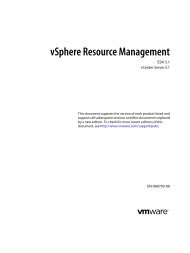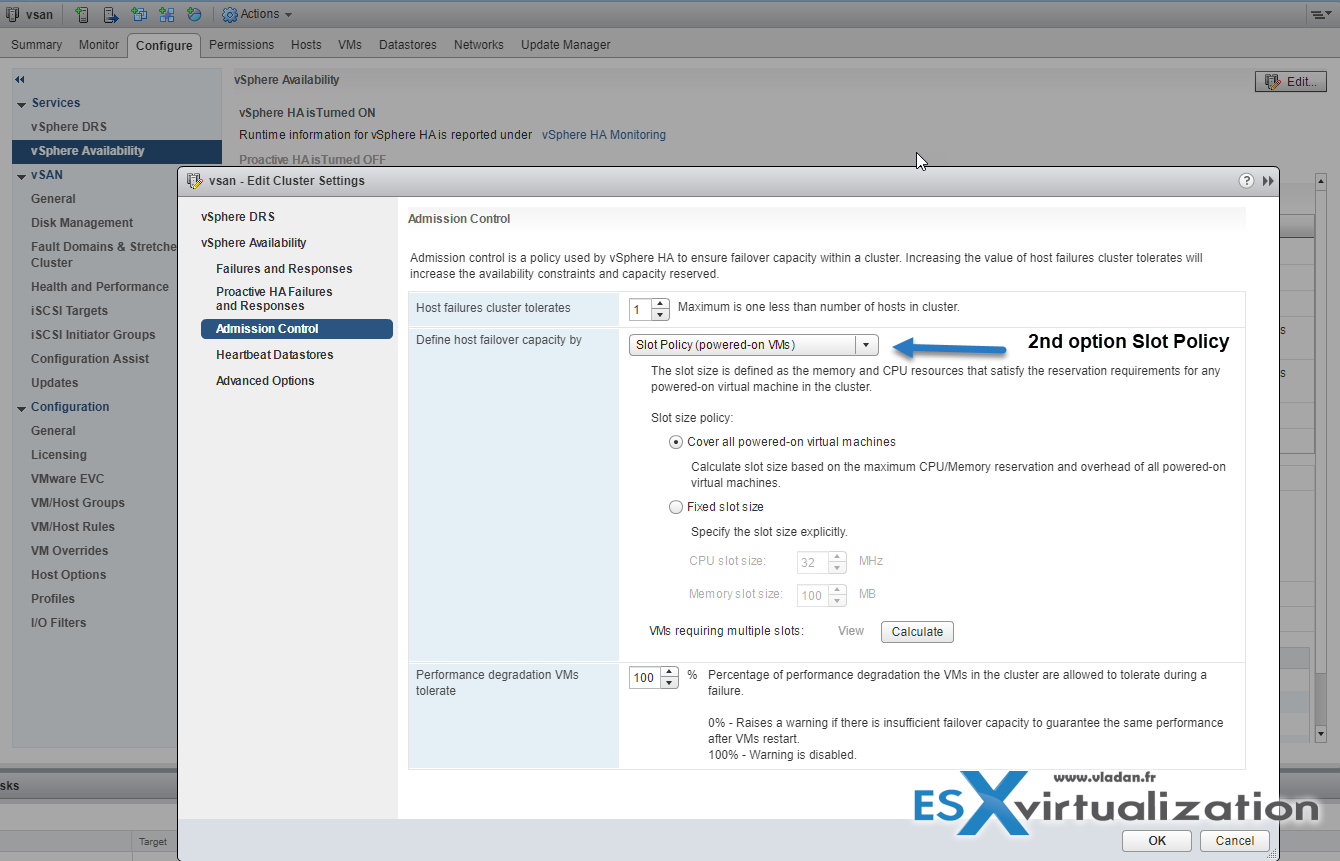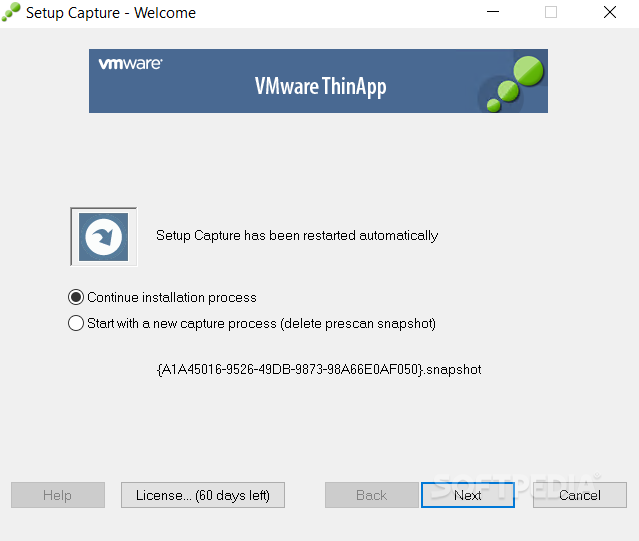Vmware Slot Size Policy
Using the slot policy, vSphere HA performs admission control in the following way: Calculates the slot size. A slot is a logical representation of memory and CPU resources. By default, it is sized to satisfy the requirements for any powered-on virtual machine in the cluster. Once your slot size has been determined, the number of slots on each host in the cluster is counted. The lower resource determines their limit - so if a host can fit 100x the CPU slot size in terms of CPU resource, but can only fit 30x the memory limit, the host has 30 slots. That number is added up for each host in the cluster. If no reservation is set anywhere HA will use the highest Memory Overhead in your cluster as the slot size for memory. This is where the amount of vCPUs come in to play, the more vCPUs you add to a virtual machine the higher will your memory overhead be. VMware vSphere HA Admission Control – Slot Policy This is the first option from the top, within the drop-down menu. In this case, the default is to “cover all powered-on VMs” and basically, it calculates the slot size based on the maximum CPU/Memory reservation and overhead of all powered-on VMs. When you select Slot Policy (Powered-on VMs) Admission Control will start resources calculations and VMs slots. If you have significant VMs or big Reservation Pools, the VM slot will also be large, and could not fit in the host failure capacity (if you have 1 or 2 host failover cluster).
- Vmware Slot Size Policy Chart
- Vmware Slot Size Policy Guide
- Vmware Slot Size Policy Tool
- Vmware Slot Size Policy Comparison
Isolation Response Time:-
By default, VMware HA has the isolation response timeout time is 15000 milliseconds Aka ,15 Seconds. Let’s say I want to avoid the restart of Virtual machines in the HA cluster because of temporary network fluctuation on my environment and i want to increase the isolation response timeout to 60000 milliseconds ( 60 seconds). The bellow is the steps to configure the isolation response time.
1. Right Click your HA cluster
2. Goto to advanced options of HA
3. Add the line “das.failuredetectiontime = 60000”
4. Click ok and isolation response time is now set to 60 seconds.
Additional Isolation Address: –
By default, VMWare HA use to ping default gateway as the isolation address if it stops receiving heartbeat.We can add an additional values in case if we are using redundant service console both belongs to different subnet.Let’s say we can add the default gateway of SC1 as first value and gateway of SC2 as the additional one using the below value

1. Right Click your HA cluster
2. Goto to advanced options of HA
3. Add the line “das.isolationaddress1 = 192.168.0.1”
4. Add the line “das.isolationaddress1 = 192.168.1.1” as the additional isolation address
Changing Default Isolation Address:-
By default, VMWare HA uses default gateway as the isolation address incase if its stop receiving heartbeat. Let’s take an example, In your organization, Firewall policy is blocking the ICMP ping or your gateway address is not pingable. In that case, HA fells itself that host is isolated. This default isolation address can be changed using the below value.
1. Right Click your HA cluster
2. Goto to advanced options of HA
3. Add the line “das.usedefaultisolationaddress = False” to disable the usage of default gateway as isolation response address.
Configuring vMotion network to use for HA heartbeat usage:-
To configure the HA heartbeat to utilize the nic which is used for Vmotion network. By this value configured, HA heartbeat communication will be send via the nic which is used for vmotion communication.
1. Right Click your HA cluster
2. Goto to advanced options of HA

3. Add the line “das.allowVmotionNetworks = True”
Configuring retries for restart of Virtual Machines:-
When the ESX host is isolated and HA tries to restart the Virtual machine running on the isolated ESX host to the non-isolated ESS host in the HA cluster. By default, The retry value is 5. You can reduce the value of reties by using the below value
1. Right Click your HA cluster
2. Goto to advanced options of HA
3. Add the line “das.maxvmrestartcount = 2” to set only 2 retry for the restart o the virtual machines
Ignore the Network redundant warning:-
We all may be come across the warnings in our HA cluster that ” No redundant network for the management network incase if we don’t have redundant service consoles. To vanish the warnings to appear due to non-redundant service console in cluster, configure the below value to TRUE.
1. Right Click your HA cluster
2. Goto to advanced options of HA
3. Add the line “das.bypassNetCompatCheck = TRUE ” to vanish the warnings from the HA Cluster.
Configuring Manual HA Slot Size:-
By default, HA slot size is determined by the Virtual machine Highest CPU and memory reservation. If no reservation is specified at the VM level, default slot size of 256 MHZ for CPU and 0 MB + memory overhead for ram will be taken as slot size. We can control the HA slot size manually by using the following values.
There are 4 options we can configure at HA advanced options related to slot size
das.slotMemInMB – Maximum Bound value for HA memory slot size
das.slotCpuInMHz – Maximum Bound value for HA CPU slot Size
das.vmMemoryMinMB – Minimum Bound value for HA memory slot size
das.vmCpuMinMHz – Minimum Bound value for HA CPU slot size
Changing HA heartbeat interval:-
By default, HA heart beat interval is 1000 milliseconds i.e 1 seconds. primary HA node will send heartbeat to other primary and secondary and secondary nodes will only send to primary node every 1 seconds. this value can be changed using the following option.
1. Right Click your HA cluster
2. Goto to advanced options of HA
3 Add the line “das.failuredetectioninterval = 3000” for heart beat to occur every 3 seconds
Changing default VM shutdown timeout:-
By default, HA waits for 300 seconds for the VM to be shutdown if the isolation response of the virtual machine is set as “shutdown” before it performs the virtual machine power off. this value can be changed using the following values.
1. Right Click your HA cluster
2. Goto to advanced options of HA
3 Add the line “das.isolationShutdownTimeout = 500” to change it to 500 seconds
Thanks for Reading.!!!!!
Vmware Slot Size Policy Chart
VMware vSphere is VMware's virtualization platform, which transforms data centers into aggregated computing infrastructures that include CPU, storage, and networking resources. vSphere manages these infrastructures as a unified operating environment, and provides you with the tools to administer the data centers that participate in that environment.
Vmware Slot Size Policy Guide
The two core components of vSphere are ESXi and vCenter Server. ESXi is the virtualization platform where you create and run virtual machines and virtual appliances. vCenter Server is the service through which you manage multiple hosts connected in a network and pool host resources.
Vmware Slot Size Policy Tool
Want to know what is in the current release of vSphere? Look at the latest vSphere release notes.
Learn About Some of Our Features
Beginning in vSphere 7.0, you can only deploy or upgrade to vCenter Server 7.0 using an appliance. The new vCenter Server appliance contains all the Platform Services Controller services from earlier releases, preserving all previous functionality, including authentication, certificate management, and licensing. All Platform Services Controller services are consolidated into vCenter Server, simplifying deployment and administration. As these services are now part of vCenter Server, they are no longer described as a part of Platform Services Controller.
vSphere 7.0 introduces vSphere Lifecycle Manager, a centralized and simplified lifecycle management mechanism for VMware ESXi 7.0 hosts. This new feature includes the functionality that Update Manager provided in previous vSphere releases. With vSphere Lifecycle Manager you can manage ESXi hosts by using images and baselines at the cluster level.
Vmware Slot Size Policy Comparison
Learn how to use vSphere with Tanzu to transform vSphere into a platform for running Kubernetes workloads natively on the hypervisor layer. With this functionality, you can enable a vSphere cluster to run Kubernetes workloads by configuring it as a Supervisor Cluster. Within the Supervisor Cluster, you can create resource pools, called Supervisor Namespaces, and configure them with dedicated memory, storage, and CPU. You can directly deploy containers natively on ESXi within a Supervisor Namespace. These containers live within a special type of pod called a vSphere Pod. You can also leverage the Tanzu Kubernetes Grid Service to easily provision Kubernetes clusters that run within dedicated Supervisor Namespaces.
You can view available vCenter Server updates and upgrades and produce interoperability reports about VMware products associated with vCenter Server using Update Planner. You can also generate pre-update reports that let you make sure your system meets the minimum software and hardware requirements for a successful upgrade of vCenter Server. The report provides information about problems that might prevent the completion of a software upgrade, and actions you can take to remedy those problems.
You can use centralized license management to manage licenses for ESXi hosts, vCenter Server, vSAN clusters, and other VMware solutions. Learn how to use the VMware vSphere Client to manage licenses in your vCenter Server environment.
Learn how to configure networking for vSphere, including how to create vSphere distributed switches and vSphere standard switches, monitor networks to analyze the traffic between virtual machines (VMs) and hosts, and manage network resources. vSphere networking is one of the most critical components in your environment, as it is how your ESXi hosts and VMs communicate.
You can learn about vSphere storage to help you plan a storage strategy for your virtual data center. You can also learn how to configure and use the virtualized and software-defined storage technologies that ESXi and vCenter Server provide. vSphere supports several storage technologies for both traditional and software-defined storage environments.
Learn how to secure your environment using vSphere security features and best practices to safeguard your environment from attack. vSphere provides comprehensive, built-in security, delivering secure applications, infrastructure, data, and access.
You can provide business continuity using vCenter High Availability (vCenter HA) and vSphere Fault Tolerance (FT). vCenter HA provides failover protection against hardware and operating system outages within your virtualized IT environment. If there is a host failure, Fault Tolerance provides continuous protection for a VM.
You can use resource pools, clusters, vSphere Distributed Resource Scheduler (DRS), vSphere Distributed Power Management (DPM), and vSphere Storage I/O Control to manage and allocate resources for ESXi hosts and vCenter Server.
Try Our Deployment and Planning Tools

The following resources are designed to help you plan your vSphere data center deployment, and effectively manage your vSphere environment.
- vSphere Hardware and Guest Operating System Compatibility Guides. An online reference that shows what hardware, converged systems, operating systems, third-party applications, and VMware products are compatible with a specific version of a VMware software product.
- VMware Product Interoperability Matrices. Provides details about the compatibility of current and earlier versions of VMware vSphere components, including ESXi, vCenter Server, and other VMware products.
- VMware Configuration Maximums. When you configure, deploy, and operate your virtual and physical equipment, you must stay at or below the maximums supported by your product. The limits presented in the Configuration Maximums tool are tested limits supported by VMware.
Access Developer and Automation Documentation
VMware {code} is a website dedicated to our developer and automation community. To learn about vSphere APIs, SDKs, and command-line interfaces, visit these VMware {code} resources:
- VMware command-line interfaces under Automation Tools
Explore Our Videos
You can learn about deploying, managing, and administering vSphere by reading the documentation, and by watching videos on the VMware Information Experience video channel.
Learn More About vSphere
To learn about vSphere and data center virtualization, see the following resources.
- Learn more about vSphere by visiting the vSphere Product Page.
- Ask questions about vSphere by visiting the vSphere Community Forum. You can get help, opinions, and feedback from other VMware users by participating in the discussion forums.
- Explore vSphere without having to install it using the VMware vSphere Hands-on Labs environment.
- Learn about the solutions vSphere provides to help you overcome your IT struggles, and create a more efficient digital infrastructure by visiting vSphere White Papers and Technical Notes.
- Read the latest products announcements, technical articles, and operations guidance from VMware on the vSphere Blog.
- Learn about benchmarking, performance architectures, and other performance-focused topics at the blog VMware VROOM!, maintained by VMware's Performance Engineering team.
- Visit the blog virtuallyGhetto by William Lam, a Staff Solutions Architect working at VMware. The blog focuses on automation, integration, and operation of the VMware Software Defined Datacenter (SDDC).

Use vSphere Documentation
The vSphere documents in HTML reflect the latest vSphere update release of each major vSphere version. For example, version 7.0 contains all the updates for 7.0.x releases. All our documentation comes in PDF format, which you can access by selecting the Download PDF icon on any page in the HTML documentation. PDFs for previous releases of vSphere are available for download in a ZIP archive format. The archive can be found under the Archive Packages heading for each major version in the table of contents on the left.
You can create custom documentation collections, containing only the content that meets your specific information needs, using MyLibrary.